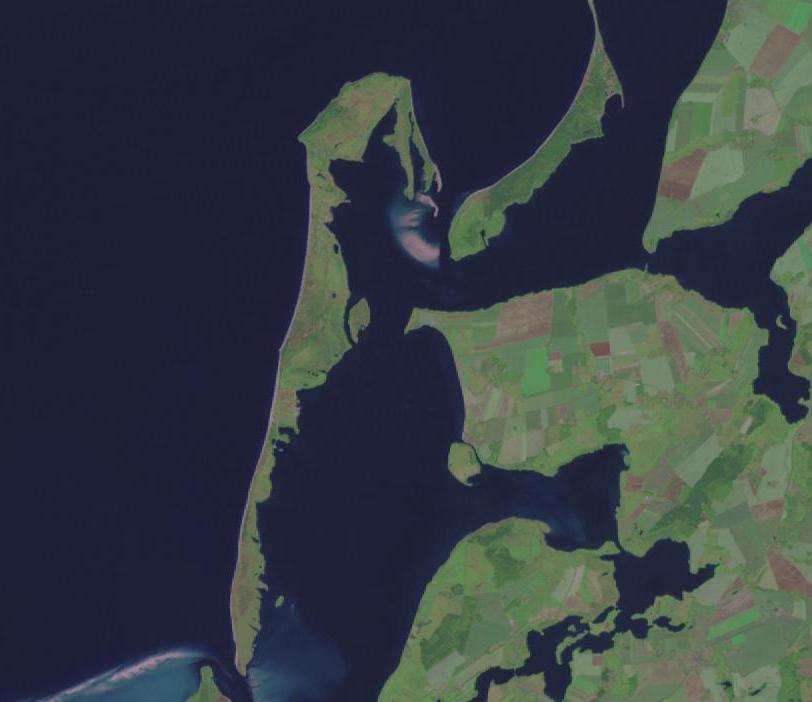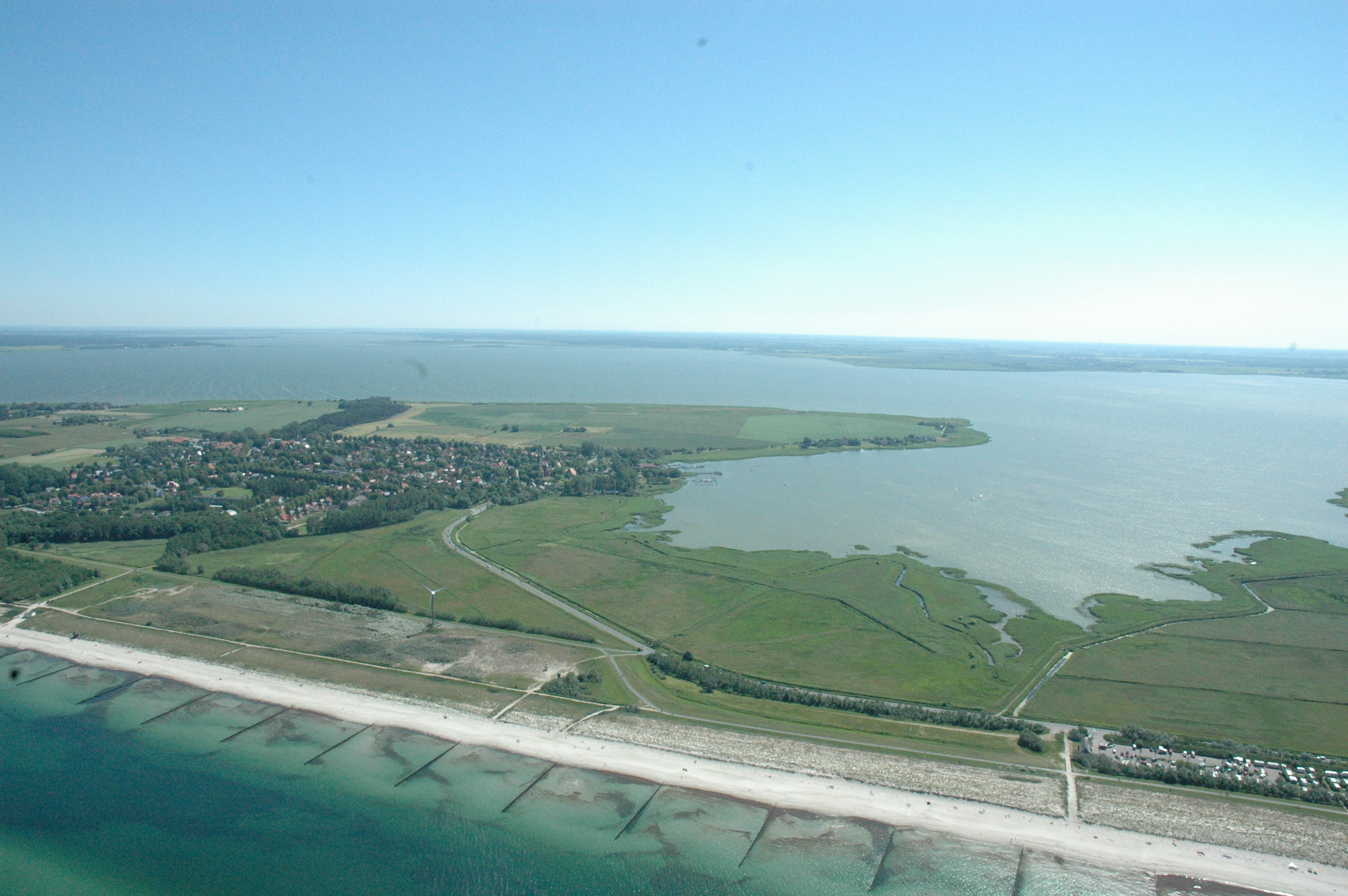|
Bodden
Bodden are briny bodies of water often forming lagoons, along the southwestern shores of the Baltic Sea, primarily in Germany's state of Mecklenburg-Vorpommern. These lagoons can be found especially around the island of Rügen, Usedom and the Fischland-Darss-Zingst peninsula. Some of them are protected reserves, forming the Western Pomerania Lagoon Area National Park. They have a distinctive geological origin and are enclosed by peninsulae, spits and islands, leaving only narrow connections to adjacent bodden or the open sea. Freshwater inflow from the mainland and saltwater inflow from the open sea, which depends on wind direction and force as well as the proximity of the bodden to the sea, result in fluctuating salt gradients and distinctive ecosystems. During the Littorina Sea transgression, an island archipelago was formed by the carving of narrow glacial basins and channels resulting from meltwater. Bodden were formed in a comparatively short period between spit ... [...More Info...] [...Related Items...] OR: [Wikipedia] [Google] [Baidu] |
Darss-Zingst Bodden Chain
The Darss-Zingst Bodden ChainMüller, Felix et al. (2010). ''Long-Term Ecological Research: Between Theory and Application'', ''Coastal Lagoons - Darss-Zingst Bodden Chain'', Sect. 12.3.3, Springer, Heidelberg, London, New York, p. 173. (german: Darß-Zingster Boddenkette) is a waterbody on the Baltic Sea coast northeast of Rostock in Germany. It consists of a string of several lagoons or ''bodden'' arranged in an east-west direction that are separated from the open sea by the Fischland-Darß-Zingst peninsula. The surface area of these lagoons is 197 km² and the average water depth is only about two metres. The individual lagoons of the Darss-Zingst Bodden Chain are the: * Saaler Bodden * Bodstedter Bodden * Barther Bodden and * Grabow (listed from west to east; not mentioned here are several smaller stretches of interlinking water). The salt content of the water rises from west to east, because only at the eastern end of the bodden chain is there a link to the Baltic Sea via ... [...More Info...] [...Related Items...] OR: [Wikipedia] [Google] [Baidu] |
Saaler Bodden
The Saaler Bodden forms the southwestern part of the Darss-Zingst Bodden Chain and lies east of the Fischland peninsula about 30 kilometres northeast of Rostock.''Die General Karte No. 1 - Schwerin-Rostock-Rügen'', 1:200,000 scale, Mairs Geographische Verlag/Falk Verlag, Ostfildern, 2008. Its average depth is around two metres, which restricts angling and the use of pleasure craft. It is a lagoon-like stretch of water known as a ''bodden'', which is typical of this part of the Baltic coastline. South of the Saaler Bodden is the town of Ribnitz-Damgarten, which is divided into two by the mouth of the 72 kilometre long Recknitz river. This southern part of the ''bodden'' is called the Lake Ribnitz (''Ribnitzer See''). Apart from the Recknitz near Damgarten, the other streams that empty into the Ribnitzer See are the ''Klosterbach'' near Ribnitz and ''Körkwitzer Bach'' and ''Fischergraben'' near Körkwitz. A stream called the ''Saaler Bach'' (in its lower reaches known as the ''Z ... [...More Info...] [...Related Items...] OR: [Wikipedia] [Google] [Baidu] |
Rügen
Rügen (; la, Rugia, ) is Germany's largest island. It is located off the Pomeranian coast in the Baltic Sea and belongs to the state of Mecklenburg-Western Pomerania. The "gateway" to Rügen island is the Hanseatic city of Stralsund, where it is linked to the mainland by road and railway via the Rügen Bridge and Causeway, two routes crossing the two-kilometre-wide Strelasund, a sound of the Baltic Sea. Rügen has a maximum length of (from north to south), a maximum width of in the south and an area of . The coast is characterized by numerous sandy beaches, lagoons () and open bays (), as well as projecting peninsulas and headlands. In June 2011, UNESCO awarded the status of a World Heritage Site to the Jasmund National Park, famous for its vast stands of beeches and chalk cliffs like King's Chair, the main landmark of Rügen island. The island of Rügen is part of the district of Vorpommern-Rügen, with its county seat in Stralsund. The towns on Rügen are: Berg ... [...More Info...] [...Related Items...] OR: [Wikipedia] [Google] [Baidu] |
Western Pomerania Lagoon Area National Park
The Western Pomerania Lagoon Area National Park at www.naturefund.de. Accessed on 27 June 2012. (''Nationalpark Vorpommersche Boddenlandschaft'') is 's largest national park, situated at the coast of the . It consists of several peninsulas, islands and lagoon shore areas in the , belonging to the district of |
Hiddensee Landsat
Hiddensee () is a car-free island in the Baltic Sea, located west of Germany's largest island, Rügen, on the German coast. The island has about 1,000 inhabitants. It was a holiday destination for East German tourists during German Democratic Republic (GDR) times, and continues to attract tourists today. It is the location of the University of Greifswald's ornithological station. Gerhart Hauptmann and Walter Felsenstein are buried there. Name The name ''Hedinsey'' surfaces as early as the ''Prose Edda'' and the ''Gesta Danorum'' written by Saxo Grammaticus and means "Island of Hedin". The legendary Norwegian king, Hedin, was supposed to have fought here for a woman or even just for gold. Under Danish rule the name ''Hedins-Oe'' ("Hedin's Island") was common. Even in 1880 the island was shown in German maps as ''Hiddensjö'' and, in 1929, in German holiday guides as ''Hiddensöe''. Its full Germanization to ''Hiddensee'' is thus relatively recent. Geography Hiddensee is ... [...More Info...] [...Related Items...] OR: [Wikipedia] [Google] [Baidu] |
Hiddensee
Hiddensee () is a car-free island in the Baltic Sea, located west of Germany's largest island, Rügen, on the German coast. The island has about 1,000 inhabitants. It was a holiday destination for East German tourists during German Democratic Republic (GDR) times, and continues to attract tourists today. It is the location of the University of Greifswald's ornithological station. Gerhart Hauptmann and Walter Felsenstein are buried there. Name The name ''Hedinsey'' surfaces as early as the ''Prose Edda'' and the ''Gesta Danorum'' written by Saxo Grammaticus and means "Island of Hedin". The legendary Norwegian king, Hedin, was supposed to have fought here for a woman or even just for gold. Under Danish rule the name ''Hedins-Oe'' ("Hedin's Island") was common. Even in 1880 the island was shown in German maps as ''Hiddensjö'' and, in 1929, in German holiday guides as ''Hiddensöe''. Its full Germanization to ''Hiddensee'' is thus relatively recent. Geography Hiddensee is ... [...More Info...] [...Related Items...] OR: [Wikipedia] [Google] [Baidu] |
Permin
The Permin is a bay in the Saaler Bodden lagoon south of Wustrow in northeast Germany. Originally, the Permin was a channel between the Saaler Bodden and the Baltic Sea and the southern estuarine channel of the River Recknitz. It borders on the Fischland in the south.''Seehäfen'' at fischland-darss-zingst.net. Retrieved 7 January 2022. Because the Permin was navigable in the 13th and 14th centuries with average water depths of around 2 to 3 metres, it formed an important waterway for trade to and from the towns of Ribnitz and Barth, although its navigability was frequently degraded by storms and silting up. Alt ... [...More Info...] [...Related Items...] OR: [Wikipedia] [Google] [Baidu] |
Zeesenboot Bodden
A ''Zeesenboot'' (plural ''Zeesenboote''), in plattdeutsch ''Zeesboot'' (pl: ''Zeesboote'') or ''Zeeskahn'' (pl.: ''Zeeskähne''), is a usually 10-metre-long, wide-hulled sailing boat of a type known as a ''Haffboot''. The name is derived from the type of fishing gear used, known as a ''zeese''. The sailing boat is designed for relatively protected, shallow waters. Today ''zeesenboote'' are mainly used for leisure sailing. History ''Zeeskähne'' were being used no later than end of the 15th century as fishing vessels, especially in the area of the Pomeranian ''bodden'' and the Stettin Lagoon. In the Stralsund Chronicle of 1449 Johannes Beckmann writes of ''Zesekahn''. The technical development of the ''Zeesboot'' from the Western Pomeranian ''Zeesekahn'' was encouraged from the second half of the 19th century because many ''Zeesen'' fishermen had travelled abroad by sea in their youth and had been able to become familiar with the sailing practices of other regions. For exam ... [...More Info...] [...Related Items...] OR: [Wikipedia] [Google] [Baidu] |
Recknitz
The Recknitz (historically known as ''Raxa'') is a river in Mecklenburg-Vorpommern in northeastern Germany. The Recknitz's glacial valley stretches as far south as the heights at Glasewitz near Güstrow. The river has no definite source, but rather builds up from streams and drainage ditches. The ditches of the ''Schaalbeke'' and ''Pludderbach'' have their water flow split between Liessow and Laage, but most of the water flows north as the Recknitz, while the lesser flow, called the ''Augraben'', runs south to the river Nebel. The lower Recknitz (from Ribnitz-Damgarten to Bad Sülze) is the historic boundary between Mecklenburg and Vorpommern. Nowadays, however, it is only a boundary between the Mecklenburg Regional Evangelical-Lutheran Church and the Pomeranian Evangelical Church. Starting at Tessin, the Recknitz is navigable by canoe the year round. A number of measures have been undertaken along the river's course to restore the natural environment. Along one stretch of 30&nb ... [...More Info...] [...Related Items...] OR: [Wikipedia] [Google] [Baidu] |
Fischland-Darß-Zingst
Fischland-Darß-Zingst or Fischland-Darss-Zingst at www.fischland-darss-zingst.net. Accessed on 18 Dec 2011. is a long in the coastal district of , in the German state of . The three parts of the peninsula, from west to ... [...More Info...] [...Related Items...] OR: [Wikipedia] [Google] [Baidu] |
Mecklenburg-Vorpommern
Mecklenburg-Vorpommern (MV; ; nds, Mäkelborg-Vörpommern), also known by its anglicized name Mecklenburg–Western Pomerania, is a state in the north-east of Germany. Of the country's sixteen states, Mecklenburg-Vorpommern ranks 14th in population; it covers an area of , making it the sixth largest German state in area; and it is 16th in population density. Schwerin is the state capital and Rostock is the largest city. Other major cities include Neubrandenburg, Stralsund, Greifswald, Wismar, and Güstrow. It was named after the 2 regions of Mecklenburg and Vorpommern (which means West Pomerania). The state was established in 1945 after World War II through the merger of the historic regions of Mecklenburg and the Prussian Western Pomerania by the Soviet military administration in Allied-occupied Germany. It became part of the German Democratic Republic in 1949, but was dissolved in 1952 during administrative reforms and its territory divided into the districts of R ... [...More Info...] [...Related Items...] OR: [Wikipedia] [Google] [Baidu] |
Lagoon
A lagoon is a shallow body of water separated from a larger body of water by a narrow landform, such as reefs, barrier islands, barrier peninsulas, or isthmuses. Lagoons are commonly divided into ''coastal lagoons'' (or ''barrier lagoons'') and '' atoll lagoons''. They have also been identified as occurring on mixed-sand and gravel coastlines. There is an overlap between bodies of water classified as coastal lagoons and bodies of water classified as estuaries. Lagoons are common coastal features around many parts of the world. Definition and terminology Lagoons are shallow, often elongated bodies of water separated from a larger body of water by a shallow or exposed shoal, coral reef, or similar feature. Some authorities include fresh water bodies in the definition of "lagoon", while others explicitly restrict "lagoon" to bodies of water with some degree of salinity. The distinction between "lagoon" and "estuary" also varies between authorities. Richard A. Davis Jr. rest ... [...More Info...] [...Related Items...] OR: [Wikipedia] [Google] [Baidu] |








.jpg)
.png)

